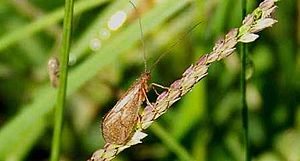Platte River caddisfly facts for kids
Quick facts for kids Platte River caddisfly |
|
|---|---|
 |
|
| Conservation status | |
| Scientific classification | |
| Kingdom: | |
| Phylum: | |
| Class: | |
| Order: | |
| Family: |
Limnephilidae
|
| Subfamily: |
Dicosmoecinae
|
| Genus: |
Ironoquia
|
| Species: |
I. plattensis
|
| Binomial name | |
| Ironoquia plattensis (Alexander & Whiles, 2000)
|
|
The Platte River caddisfly (Ironoquia plattensis) is a special kind of caddisfly. It belongs to the family Limnephilidae. This insect is found only in Nebraska, which means it is endemic there. Scientists first officially described this caddisfly in the year 2000.
Contents
Its Home and Life Cycle
This caddisfly was first found living near the Platte River in central Nebraska. Its main home, called its type locality, is close to Grand Island. It lives in small, wet areas called sloughs.
The caddisfly goes through its whole life cycle in these small wetland spots. In the spring, the larva moves from the water to the land. It then rests through the summer, a process called aestivation. This happens when the wetlands dry out during the warmer months.
In the autumn, the larva turns into a pupa. Then, in September and October, the adult caddisflies fly around and lay their eggs.
Finding the Caddisfly
When the Platte River caddisfly was first discovered, scientists thought there were many of them in their main home. But they also thought the caddisfly lived in only a very small area.
Later, more surveys were done to find the insect in other places. After a year of looking, the United States Fish and Wildlife Service decided in 2012 that the caddisfly did not need to be listed as an endangered species.
This agency did more than 100 surveys. They found the insect at 35 different places across a large part of Nebraska. Many of these places seemed safe from threats.
Why This Caddisfly is Important
After the first decision by the Fish and Wildlife Service, more studies looked into the caddisfly's life. They found that its living areas were actually broken up into smaller pieces. It only lives in river habitats that are not disturbed or changed by people.
This means the caddisfly can be an indicator species. An indicator species is an animal that shows if a local wetland habitat is healthy. If the habitat gets damaged, this insect disappears.
For example, the caddisfly is not found where the Platte River has been changed. People have made the river into straight channels and moved water into canals for irrigation. This removes the warm-water sloughs along the river, which changes the environment too much for the caddisfly to live there.
Other changes to the Platte River in this area include controlling how much water flows. Also, some wet meadows along the river have been turned into farm fields. The water underground, called the aquifer, has also been used up.
Early studies of farmland near the river suggest that too much livestock grazing can harm the wetland plants. It's better to move grazing animals around to let nature recover.
Other Animals in Its Home
Scientists have also seen other animals living in the same areas as the Platte River caddisfly. These include fish like the plains topminnow (Fundulus sciadicus), brassy minnow (Hybognathus hankinsoni), fathead minnow (Pimephales promelas), and Iowa darter (Etheostoma exile).
Amphibians like the plains leopard frog (Lithobates blairi), western chorus frog (Pseudacris triseriata), and Woodhouse's toad (Anaxyrus woodhousii) also live there.
The Platte River caddisfly and many other insects are food for these animals. The caddisfly is a common food source for the brook stickleback (Culaea inconstans).


